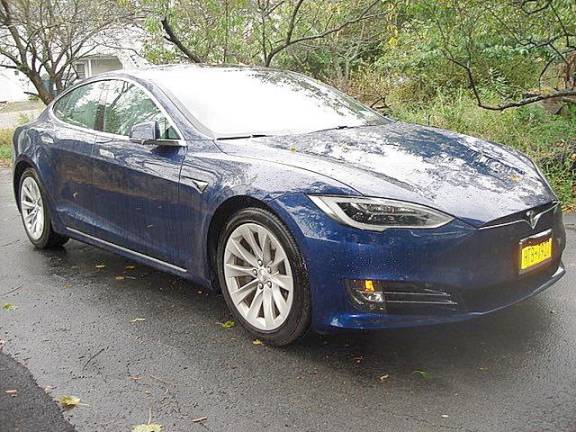Mike Edelstein casts off the fetters of fossil fuels
Goshen. He practices his devotion to a clean environment and sustainable energy future at work, at home, and in his car.


Goshen resident Michael Edelstein has known for 50 years that the road to hell is paved with petroleum.
“The '70s was the birth of the environmental movement, when environmental laws were passed, as well as the start of the energy crisis," said Edelstein, who heads the environmental studies program at Ramapo College in Mahwah, N.J., where he's taught since 1974. "I realized at that time, our dependence on petroleum was a disaster and our energy decisions were profoundly wrong. We knew then we could use solar and renewable energy to avoid profound environmental and social destruction that we’ve progressively magnified many times over."
Edelstein has devoted his life to bettering the environment. He earned his Ph.D in social psychology from the University of Buffalo, after completing his undergraduate work at the University of Pittsburgh in 1970. Working with energy physicist William Makofske, he helped build Ramapo into a leading center for pursuing energy alternatives. He's also president of Orange Environment, which follows local development that affects the environment.
Students at the Ramapo College Alternative Energy Center were engaged in designing and building passive solar structures on a ten-acre site that integrate key elements of sustainable community living. The buildings employ solar and wind energy, recycling, and sustainable food production. Edelstein said Ramapo leads the way in anticipating the consequences of our collective dependence on fossil fuel.
Home sweet home
He practices what he preaches when he returns each day to his energy-saving home in his energy-saving car. He converted his first house in Goshen, a one-room schoolhouse, to passive solar heat, using a moderate amount of wood heat as a back-up. A stand of maple trees cooled the house in summer.
“They did a great job,” Edelstein said.
He planted an orchard and other food plants on the property.
A deciding factor in purchasing his current house on Murray Avenue was that it included a large side lot, where he grows many of his own fruits and vegetables. But an equally compelling factor is that the roomy, two-story Victorian-style home was adaptable to passive solar heat. Solar panels installed on the roof supply electricity. Until recently, when he began charging electric vehicles, the panels supplied all the electricity he needed for his home.
To augment his supply, Edelstein is contemplating purchasing electricity from a community solar or equivalent facility.
“The solar panels don’t have to be just on my roof to be effective,” he said.
To retain additional heat, Edelstein is enclosing his wraparound porch. When it’s completed, the enclosure will retain the sun’s rays pouring in on the south to west side to heat the porch. Excess heat, stored in the tile floor, will be released at night or circulated into the building.
“The beauty of this is that it can be used as a ‘sun porch,’” said Edelstein. “All the projects that I have undertaken add to the energy efficiency of my home.”
Edelstein previously improved the energy efficiency of the house with insulation and energy-saving appliances.
On the road, sustainably
In the early 2000s, Edelstein purchased his first Toyota Prius hybrid electric car. With the manufacturer adding a battery, the Prius is a “revolutionary step” in car design, he said. Although the Prius still used gasoline, it got 50 miles to the gallon and dramatically reduced tailpipe emissions. He has owned five Priuses.
In working toward his ultimate goal of using no fossil fuels at all, Edelstein’s next car choice was the all-electric Tesla. He effectively runs the car on renewable energy, severing his dependence on fossil fuels and avoiding greenhouse and other pollutants.
Edelstein has high praise for Elon Musk, co-founder, CEO, and product architect at Tesla Motors.
“He truly is one of the people who has acted with foresight and acted for the world as few others have done," he said.
The all-electric Tesla is expensive, but Edelstein says the early Prius started out with a high price tag that eventually went down. He predicts the same will be true of the Tesla.
“Electric cars were initially much more expensive than conventional gas vehicles but are increasingly competitive," he said. "Early responders paid a high price to make sure the technology would become available for all."
The original model, the Tesla S, costs upwards from $90,000.
After the Model S, Tesla created an SUV version, the Model X. To move toward better profitability and build recognition, Tesla built the Model 3.
“This is the equivalent of the Model T that Ford developed so everyone could afford a car,” said Edelstein.
The Model 3 is still expensive, but stripped down, the cost is under $40,000.
“The Tesla is an excellent car to drive, very comfortable, besides the fact that it doesn’t use gasoline and has zero emissions,” said Edelstein.
One of his favorite Tesla features includes the regenerative braking system that allows electricity to be generated whenever the accelerator is released. That feature allows the driver to stop the car without applying the brakes, giving excellent driver control and added safety.
Edelstein charges the Tesla once a week, overnight. He said the driving range is between 250 and 300 miles, and that recharging stations are located within 100 miles of each other.
“There’s nowhere I can’t go without a charging station within range,” he said.
Edelstein said the driverless electric cars of the future will eliminate the need for families to own more than one or perhaps any car. These vehicles can bring a child to school after dropping the parents off at work, he said. The same or a different vehicle would pick them up later.
“In another generation, I won’t need to own a car at all,” he said.